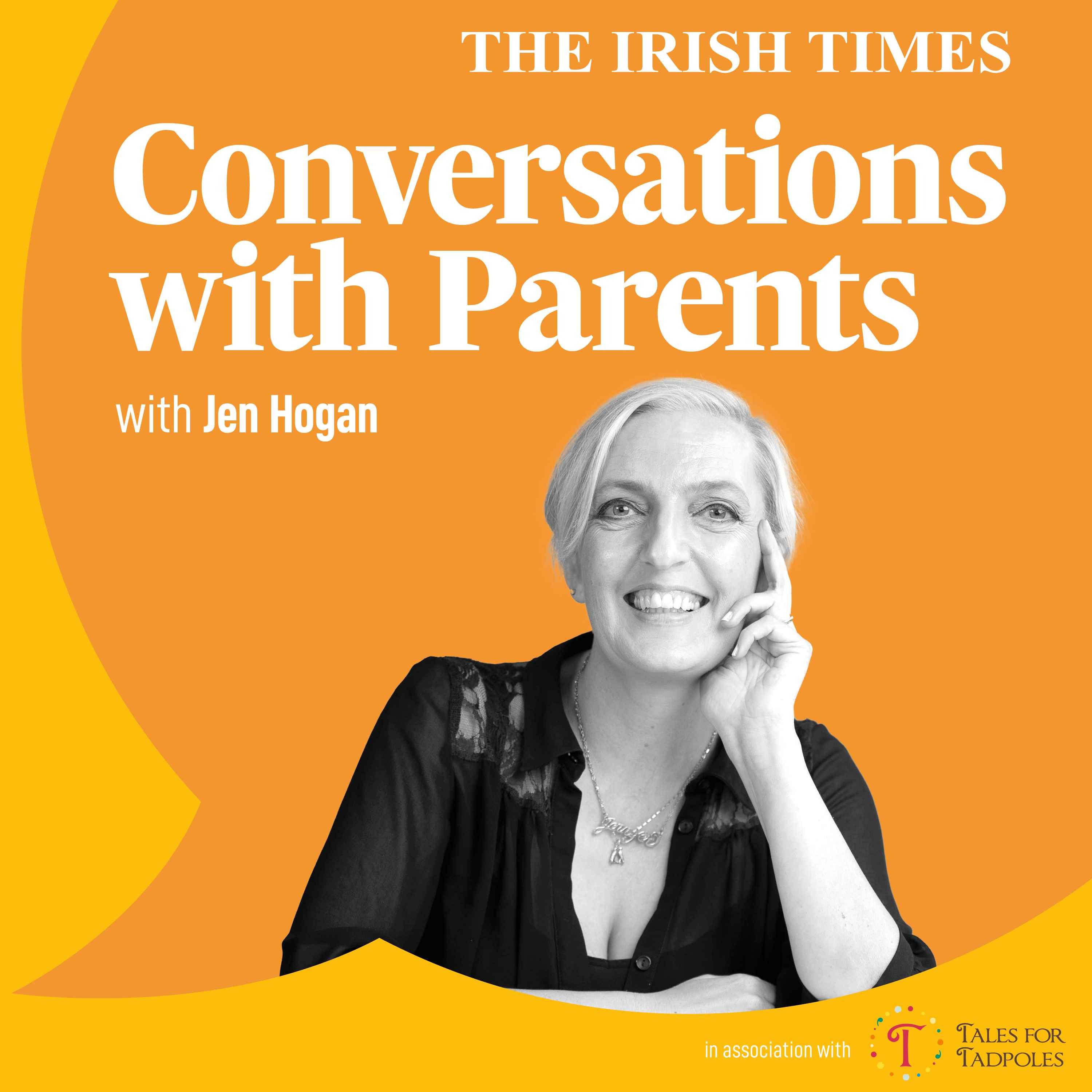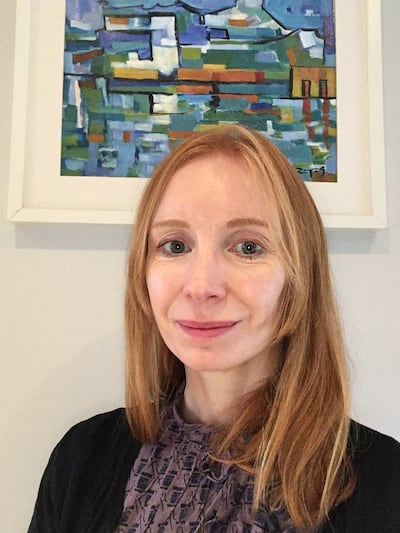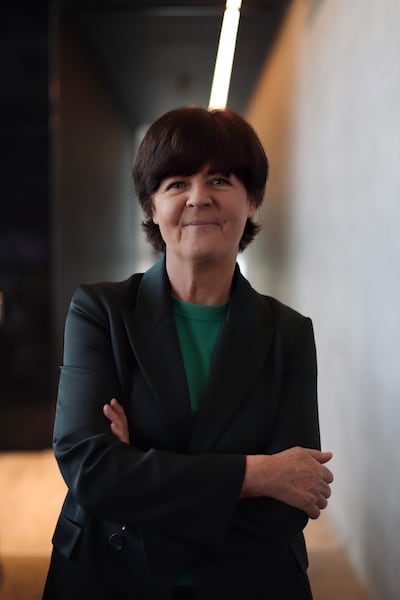“From today you cannot drive, you have to give up work and you can’t be on your own for longer than half an hour.”
For Mary de Courcy, a psychotherapist who was feeling pretty well up to that moment, this was the most shocking part of being told she had a grade-four brain tumour.
“I didn’t really have any symptoms,” she says. It was the summer of 2022 and a few weeks previously she had been on holiday in Venice when she became aware of a strange sensation of being in an echo chamber. On her return home to Booterstown, Co Dublin, she decided to go to the GP, “who, thankfully, did not dismiss me with two paracetamol and say come back in two weeks, which she could have because I looked fine.”
Instead, she was referred to an ear, nose and throat specialist, as it seemed to be a possible ear problem. He ordered an MRI, “and I knew from the faces of the radiographers that there was something wrong because they would not look at me”, she says.
RM Block
Next stop was a neurologist, a person they knew, who took one look at the scan and said he did not think it was vascular. He sent her to a consultant at Beaumont who delivered the diagnosis and told her he was taking her in the following week for surgery.
“The whole process took, say, six weeks, that’s all, from going to the GP to having the operation. So I was very lucky.”
She had asked what the prognosis was without surgery.
About four months, was the reply.
And with surgery?
Possibly 18 months to two years.
That was just over two years ago and de Courcy has not only this year celebrated her 70th birthday, which was a milestone she was determined to reach, but she is also back driving and singing with the National Symphony Chorus. However, she no longer practises as a psychotherapist.

Maïa Dunphy: 'I was terrified of becoming a single parent'
Although much of the year after the seven-hour operation – which left her with 42 staples across her head – passed in a blur, she does have one clear memory from the immediate aftermath. The surgeon stood at the end of her bed and told her he could not take all of the glioblastoma tumour out because, otherwise, she would have lost functionality on her left-hand side. “So I thanked him ... I haven’t lost anything.”
That September she began nine months of chemotherapy and, concurrently, 42 sessions of daily radiotherapy, before her treatment concluded in May 2023. It is at this stage that brain tumour survivors often talk about feeling like they have fallen off a cliff regarding health services and other supports to help them get on with life. Brain tumours typically occur in people of working age, and there can be significant challenges in returning to employment.
To look at how to address this dearth of support, researchers at the Royal College of Surgeons in Ireland (RCSI) have embarked on a three-year programme to explore the survivorship and rehabilitation needs of people with a brain tumour. The study is titled Brain-Restore, and has the tagline: “Surgery, chemotherapy, radiotherapy, but now what?”

When study co-investigator Dr Ailish Malone was working as a physiotherapist in Beaumont Hospital, Dublin, she saw how patients were able to access world-class neurosurgery and oncology services, “but there was a real gap in helping people to return to their lives”.
Brain tumours are a variable group of conditions, with a hundred different types, she says. Their effect is also linked to where they grow in the brain. More than 450 people in Ireland every year are diagnosed with a primary brain tumour, which may be malignant or benign. Many more patients develop secondary brain tumours from other cancers elsewhere in the body. Even a benign tumour can cause complications due to damage at the site of growth or the impact of surgery to remove it. “I would have worked with patients who had significant physical problems after brain tumours, like limb weakness, difficulties walking,” says Dr Malone. There can also be memory difficulties and personality changes.
“A common problem that affects practically everybody after brain tumour, regardless of whether they have a low-grade, low-invasive, or a high-grade tumour, is fatigue. They have fatigue that comes both from having a brain injury and cancer treatment, so it’s kind of like a double whammy.”
Rehabilitation can mean different things to different people. “The World Health Organisation defines it as a set of interventions designed to optimise functioning of people with health conditions in a regular environment – and that was the part that we really wanted to tackle with this study.” Brain-Restore, which is being funded by Health Research Charities Ireland, the Health Research Board and Breakthrough Cancer, is looking at how quality of life can be improved, whether the brain tumour patient’s life expectancy is long or shorter. However, as symptoms may fluctuate, it can be difficult, says Dr Malone, to plan the care people need.
“The effects play out over quite a long period of time. It will be our challenge to make recommendations for practice that can account for that because sometimes when people finish their treatment, that can often be their last appointment, other than coming back with their scans.
“How do we support people with the interventions they need before they’ve been struggling for months, or before they’ve given up on things, or before their carers and family are completely overwhelmed?”
Dr Malone is leading a strand of Brain-Restore that involves talking to patients and families about their needs and what they have found lacking in services. The study is still recruiting patients for this and are finding it hard to get those within their first year of diagnosis, probably because it is such a difficult time, she acknowledges.

The project’s charity partner, Brain Tumour Ireland, is helping in this regard. Chief executive Fiona Keegan says it hears, through peer support groups for patients and for carers, of “massive gaps” in services, particularly at community level. There is intense focus on a patient having surgery and undergoing follow-up treatment but no “pathway” for what comes next. They are not told “you may expect this and this is who’s going to look after this. So often they will call us.” She will suggest patients attached to a large hospital such as Beaumont go back to the relevant clinical nurse specialists, or to ask their GP what is available.
But that can be hit and miss, says Keegan, because it is a rare disease. “A GP would say to us ‘We might go through our whole career and never see somebody with brain tumour’. So it’s not on their radar what might be available for the brain tumour patient in the community.”
There can also be misunderstandings about the work of palliative care teams in the community and people get scared if that is suggested as an option. “The minute you say that, they think it’s all over.” Whereas “if you can get palliative care in earlier, they’re really good at symptom management and they’re also very good with just talking to the family around what they might expect as things progress”.
De Courcy experienced that sense of being adrift after her treatment ended. “Once I was through the chemotherapy and the radiotherapy, I didn’t know where to go when I was feeling rotten.” For her, “rotten” meant “having to lie down all the time; not able to think”.
She struggled with periods of feeing “dispirited” and has availed of counselling offered by Arc cancer support services. She opted to spread out the eight sessions and still has one more to go.
De Courcy, who is contributing to Brain-Restore, also points out that she was very fortunate to have her husband, Gabriel Cooney, driving her to all appointments and coming in and taking notes when much of it was a haze to her. How somebody in her position would manage without such constant personal support is another issue that needs to be looked at, she suggests.
For rehabilitation of people with brain tumours, Malone believes that sometimes it is a case of needing to “join the dots” of things that work for other conditions or in other places, or learning from pockets of good experience and trying to ensure such supports are available to all those who are struggling. There also needs to be a shift in thinking to wider recognition of a brain tumour as a brain injury that is amenable to, and needs, rehabilitation.
While surgery and follow-up treatment is carried out in two centres of excellence – Beaumont and Cork University Hospital – ultimately these patients go back into the community, where some health professionals have rarely if ever encountered somebody with a brain tumour and don’t feel competent to work with them.
This could be addressed through education, says Malone. “It’s just arming them with the knowledge that they need to manage the person in front of them and not to fear the complexity.” The way they are already working with people after a stroke, or who are living with multiple sclerosis, will in many cases benefit people with brain tumours too.
The Brain-Restore team is not waiting for the conclusion of their study at the end of 2025 to advocate change. There is a panel of healthcare professionals from a range of disciplines working with them to see how findings can be acted on as they emerge.
“We know that the research life cycle can be really long,” says Malone. “The rule of thumb is it can be up to 17 years from knowledge generation to implementation. The people we work with don’t have 17 years; they need it right now.”
For instance they have already identified communication problems between the specialised neuro-oncology services and community practitioners. “Even some of the forms that people use are not really capturing what you need to know about someone with a brain tumour.”
I still haven’t gone shopping. That’s too overwhelming altogether. Crowds and social occasions, I avoid them
— Mary de Courcy
De Courcy considers herself as living with a brain tumour, since a part is still there. But returning for a scan every three months provides reassurance that it is not regrowing. However, she is realistic that it might and takes each days as it comes.
“It’s not like I’m whooping up and down.” Still, she has been told she is in the 10 per cent of brain tumour patients who come through surgery without any lasting incapacities.
Lack of confidence was a big thing as she tried to pick the reins of her life. She worried about being able to cope alone in different situations and could not face trying public transport for a long time. But throughout her recovery, four grandsons aged nine to three, who just found it quite funny she had lost her hair, were a positive distraction.
Now she has occasional balance problems, although doing yoga has helped a lot. There is also brain fog sometimes when she cannot remember somebody’s a name, although she is not sure if the latter is just due to age.
“I still haven’t gone shopping, I find the whole thing of getting out, going into a shop, choosing something, that’s too overwhelming altogether. Crowds and social occasions, I avoid them.”
Yet she has found her return to the ranks of the 140-strong National Symphony Chorus comforting, with her singing voice and ability to read music unimpaired. As they perform Puccini’s Messa di Gloria in the National Concert Hall this Friday (October 25th), she says she will not be aware of the tinnitus that has developed since her brain surgery.
It is at quiet times, such as the middle of the night, it “whistles and thumps away”. But “I did do a spin on it”, she adds: “it means I am alive.”
- Brain-Restore’s principal investigator, Prof Kathleen Bennett, will be speaking at an information evening on Brain Tumour Research in Trinity College Dublin on Wednesday, October 23rd, as part of National Brain Tumour Awareness Week.
- Sign up for push alerts and have the best news, analysis and comment delivered directly to your phone
- Join The Irish Times on WhatsApp and stay up to date
- Listen to our Inside Politics podcast for the best political chat and analysis




















